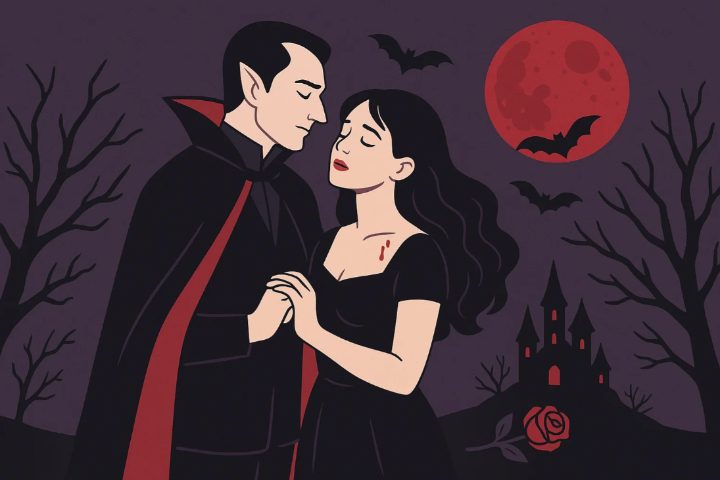Dark romance is a literary genre that has won the interests of the entire world of teenagers. Moreover, digital platforms and social media promote its growth. However, this concerns many parents globally. To give the teenagers direction in their reading material, it is essential to know the dark romance meaning, its main peculiarities, and influences on the young readers. Here, parents will receive useful tips on how to talk about such a genre and control the online activity of their teens.
What is dark romance?
Dark romance is a subgenre of romance fiction which focuses on the darker sides of romance and relationships. Obsession, uneven power dynamics, immoral characters are the topics of it. Such narratives are usually highly emotional and risky and deal with taboo situations. The described relationships are typically long lasting, tangled, and even unhealthy. The definition of dark romance also applies to age rating, as there is mature content, i.e. sex scenes and emotional manipulation are detailed. The genre is a stretch into classic romance as the author asks the reader to feel the unpleasant realities of desire and control.



The key characteristics of dark romance
- Power imbalance: In most cases, one of the partners is dominant and creates frustrations and tensions.
- Morally grey characters: The main characters can do something ethically dubious or even illegal.
- Strong emotions: Themes of obsession, fear and passion are common.
- Taboo or forbidden love: Relationships can go across societies or law.
- Gloomy places: The aroma is usually gloomy, gothic or threatening.
- Greater emotional and physical danger: Characters are also under a great threat and danger.
- Add complicated psychology: Manipulation, control, and trauma are common elements in the plot.
- Dark romance sex: Sex scenes may feature BDSM and dominance and non-standard sexual relationships.
How is dark romance different from traditional romance?
It is important that concerned parents know about the distinctions between dark romance and traditional romance. Although these two genres center around romantic relationships, the methods of their exploration and the theme differ significantly.
| Aspect | Tradition romance | Dark romance |
|---|---|---|
| Tone | Hopeful and light | Intense |
| Relationship dynamics | Balance with mutual respect | Power imbalances |
| Character morality | Likeable | Morally ambiguous |
| Themes | Love, trust, and overcoming obstacles | Obsession and control |
| Ending | Predictable and mostly happy | Mostly hard-won |
| Sexual content | Mild | Explicit with BDSM description |
| Setting | Everyday | Gritty and gothic |
Use parental controls to protect teens from inappropriate content.
How does dark romance become a popular trend?
Dark romance has gained popularity over the last decade. This has been a trend for several reasons, particularly among teenagers and young adults.
- Digital publishing and self-publishing
The genre of novels have become increasingly accessible due to the development of digital publishing, which simplifies the work of authors. Services like Amazon Kindle Direct Publishing enable writers to bypass traditional gatekeepers and reach a global audience.
- Online networks and social media
Apps such as TikTok, Instagram, and Goodreads have been widely used to promote dark romance. In particular, the #BookTok community on TikTok has popularized these kinds of books with the help of viral videos, emotional reviews, and aesthetic playlists. Adolescents hear these suggestions every day, and this aspect causes interest and curiosity.
- Influencer recommendations and peer recommendations
The romance genre is a type of book that influencers and online communities often recommend as a must-read. Peer suggestions are essential to teens, and hence, the possibility of picking such books increases.
- Success stories in the mainstream
Books such as Fifty Shades of Grey and Haunting Adeline have pushed the dark romance to the mainstream. Their success in commerce has led publishers to invest in titles within the same genre, thereby boosting awareness of the genre.
- Catharsis and escapism
Dark romance offers readers an emotional thrill and a break from their routine lives. This is because this genre elicits a strong emotional response and is particularly interesting to teenagers seeking emotional release.
Is dark romance appropriate for teens?
The question of the suitability of dark romance for teenagers is a subject of controversy. The explicit material and mature concepts of this genre raise significant concerns among parents and teachers.
- Mature themes
Manipulation, control, unhealthy relationships, and explicit sexual content are part of dark romance. Other aspects show rebellious violence, abuse, or any unwanted acts. The subjects may be highly worrying or perplexing to younger readers.
- Confusion, fantasy, and reality
The youth might not be able to distinguish between fantasy love and genuine love. The glorification of unhealthy actions can distort perceptions of love and consent.
- Emotional impact
The dark romance is full of emotions and stakes so high that it may make any reader anxious, confused, or even traumatized. The psychological complexity of the genre can be tremendously overwhelming for the teens, further establishing emotional maturity.
- Expert recommendations
According to most experts, dark romance should be left to adults, typically for those 18 years and above. Content warnings are not a new concept, yet not every teenager listens to them. So, parents should watch out for what their kids read.
How can dark romance impact minors?
- Distorted views of relationships: Teens may develop unhealthy ideas about love, power, and consent.
- Normalization of toxic behaviors: Manipulation, abuse, and lack of consent can be romanticized.
- Emotional distress: Intense themes may cause anxiety, confusion, or trauma, especially for sensitive readers.
- Difficulty distinguishing fiction from reality: Young readers may struggle to separate fantasy from real-life expectations.
- Increased risk for unhealthy relationships: Teens may seek or tolerate toxic dynamics, believing them to be desirable.
How can parents discuss dark romance with their teens?
Communication is the key to discussing any hypersensitive issue. The conversation between parents and children should be open, friendly, and non-judgmental, rather than fearful.
- Have an inquiry mind, not a judgmental one
You should ask your teen about what they like about such stories. Do not break down their explanations, but listen to them.
- Explain the difference between fiction and reality
Describe that the real relationship must be secure, respectful, and mutual. Help your teen understand that dark romance is not a realistic representation of what should be in real life.
- Speak about healthy emotional boundaries
Emphasize the importance of consent, open communication, and mutual respect in any relationship. Draw examples of what works and what does not using the stories.
- Reading in pairs or co-read or review together
Read what your teenager is reading or have them explain the plots. This may shed light on what they are going through, and it may lead to further discussions.
- Balance through good models
Watch or read media that demonstrate positive relationships with your teen. Comment on what distinguishes these instances and black romance relationships.
- Validate emotions
Show sensitivity to your teen and encourage them to assess the material critically. Accept their interests, but help them become more understanding of portrayed situations.
- Obtain consultation services as necessary
If you notice any profound changes in your teen’s behavior or emotional well-being, consider consulting a mental health expert.
Bonus: How to know if your teens watch/read dark romance online?
You can also track your teenage child’s online activity to understand their reading patterns. The following are some of the more realistic ways of determining whether or not your teen is reading the dark romance content:
Look through their bookshelves and apps to read books
Ask around or target the standard dark romance titles or hashtags that are used, such as #darkromancebooks. Note the covers and art, which often reveal the genre.
Check social media
Check whether your teenager is a member of BookTok, Bookstagram, or any other more dark romance-prone group. Look at their liked or stored posts to find recommendations for books.
Review the history of the browser and the search history
Find searches on the meaning and definition of dark romance, or a particular book. This may give us a clue as to what they are interested in.
Take advantage of parental control apps
Specific tools, such as FlashGet Kids, help parents keep track of the child’s online activity, restrict certain apps, and alert in case suspicious activity is detected. These applications will keep you updated without intruding on your teenager’s life. Moreover, this app works in stealth mode. So, your teen won’t feel like their privacy is being invaded while you try to keep them safe.



Talk openly
Ask your teen what they enjoy reading and the reasons why they like specific genres. It is better through open communication than it is through spying.
Commune online
There is an option to join parent forums or online communities, where you can continue to learn about what is trendy in the world of teenage literature.
Seek out behaviour change
Another signal that your teenager is accessing mature material is when they start being secretive, secluded, and even obsessed with some books and magazines.
Establish digital boundaries
Establish strict rules for internet use, including time restrictions and specific types of content to be viewed. Help your teenager understand why you are limiting them in this way.
Wrap up
Dark Romance can be described as an intriguing and yet contentious genre, exploring the darker aspects of love and desire. It is high on pathos, power politics, and adult themes such as sex scenes between a dark romance and forbidden relationships. With the advent of digital platforms and social media, the genre has experienced a massive increase in popularity, attracting a younger and more active fan base.
Dark romance may be a source of emotional release as well as colorful storytelling, but it has its dangers for teenagers. These are the normalisation of bad relationships, grey areas of consent, and possible emotional trauma. The majority of the professionals advise that dark romance should be allowed only to adults, mostly those who are 18 and above.
FAQs
Typically, No. The level of maturation of the teenager should be considered, as well as the content itself. The majority of professionals suggest using it with caution due to mature content.
No. Younger readers will typically face more dangers, and even when emotional understanding and the ability to think critically can be improved, the influence can rarely be beneficial to adolescents.
The majority of dark romance books may carry an 18+ age rating, and individuals under 16 should not read the explicit content.
Toxic romance can be a poor education in the manifestations of healthy relationships and consent, especially for impressionable readers. Critical discussion is necessary.

